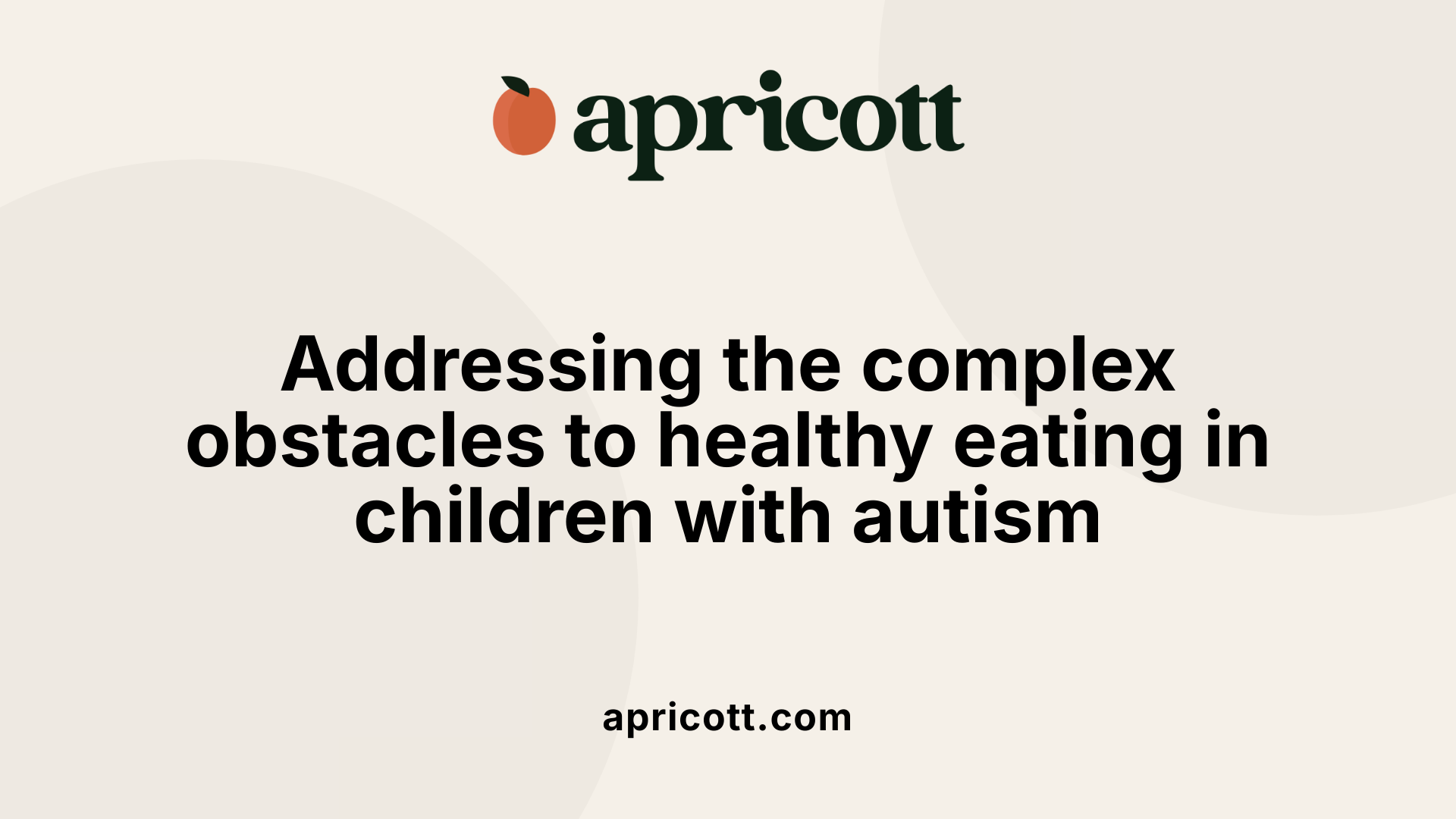August 13, 2025
Understanding Feeding Challenges in Autism Spectrum Disorder
Autism Spectrum Disorder (ASD) often brings about unique challenges, among which picky eating behaviors are notably prevalent. While such behaviors can be observed in typically developing children, those with autism tend to experience more pronounced and persistent feeding issues. This comprehensive overview explores why these feeding difficulties occur, their underlying causes, associated sensory sensitivities, and practical strategies for caregivers to support healthy eating habits.
Research indicates that a large proportion of children with autism spectrum disorder (ASD) experience significant feeding difficulties. Studies show that between 46% and 89% of children with ASD have some form of food selectivity or eating problems. These issues often manifest as extremely limited diets, reluctance to try new foods, and preferences for specific textures, flavors, or presented forms. Such behaviors can lead to nutritional deficiencies, affecting their overall health.
The high prevalence rate highlights that picky eating is a common concern for children on the spectrum. It is often associated with sensory sensitivities and behavioral patterns typical of autism, which influence their eating habits and food choices.
While many children are naturally fussy eaters at some stages of development, autism-related selective eating tends to be more intense and persistent. Unlike typical fussiness, which may resolve with maturity and exposure, children with ASD often display extreme rigidity around food. This may include refusing entire food groups like fruits or vegetables, insisting on sameness in meal routines, or avoiding foods due to sensory sensitivities.
Additionally, children with autism may exhibit ritualistic and idiosyncratic behaviors during eating, such as obsessively arranging food or only eating foods of a certain color or texture. These behaviors are rooted in their sensory processing differences rather than mere preference or stubbornness.
Sensory sensitivities are a primary factor driving picky eating behaviors in children with ASD. Over-responsiveness or under-responsiveness to textures, smells, tastes, and temperatures can make certain foods unappealing or even intolerable.
For example, a child may gag or refuse to eat foods with a certain texture, such as gritty or slimy foods, or they might be overwhelmed by strong smells. These sensory processing differences significantly contribute to the limited food repertoire seen in autistic children.
Experts recommend strategies like gradual food introduction, creating sensory-friendly mealtime environments, and positive reinforcement to expand their diet. Consulting healthcare professionals and utilizing tailored approaches can greatly improve their nutritional intake and overall well-being.
Children with autism often exhibit highly selective eating habits owing to a combination of sensory sensitivities, medical issues, and behavioral routines. Many autistic children are hypersensitive or under-sensitive to sensory stimuli such as taste, smell, texture, and visual appearance of foods. For example, they may avoid foods with certain textures, preferring either very soft or very crunchy options, which limits their diet.
In addition, gastrointestinal problems are common in children with autism and include issues like constipation, diarrhea, acid reflux, and eosinophilic esophagitis. These conditions can cause discomfort during or after meals, leading children to refuse certain foods, especially those that aggravate their symptoms.
Behavioral and routine factors also play a significant role. Children on the autism spectrum often prefer routine and predictable environments, including predictable meal patterns and food choices, to minimize anxiety and sensory overload. Disruptions or unfamiliar foods can trigger stress and refusal behaviors.
Environmental influences, such as noisy mealtimes, strong smells, or chaotic settings, may heighten sensory sensitivities, further discouraging certain foods. Past unpleasant food experiences, oral-motor delays, or pain during eating can also contribute to persistent picky eating.
Overall, the convergence of sensory sensitivities, gastrointestinal issues, and a preference for structured routines significantly contributes to selective eating behaviors in children with autism. Understanding these factors is crucial for developing supportive strategies that encourage healthier and more varied diets.

Many children on the autism spectrum experience sensory challenges related to food, which significantly shape their eating behaviors. These sensitivities can involve disliking certain tastes, textures, smells, or appearances of food. For example, some autistic children may refuse foods with specific textures like sticky, crunchy, or slimy, which can make their diets highly restricted.
Autistic individuals often have heightened or diminished responses to sensory stimuli, a condition known as sensory processing disorder. This can lead to anxieties around swallowing or fear of choking, especially with foods that are perceived as difficult or unpleasant in texture.
In addition to taste and texture, visual aspects such as food color and presentation can influence acceptance. Many prefer foods that are visually familiar or predictable, seeking routine to lessen anxiety.
Environmental sensory factors—such as bright lighting, loud noises, or undesirable smells—can exacerbate eating difficulties. Furthermore, some autistic people have difficulty with interoception—the ability to sense internal cues like hunger and fullness—resulting in irregular eating patterns.
Recognizing these sensory issues is important in understanding why autistic children may have selective diets or exhibit behaviors like gagging, food refusal, or ritualistic eating routines. Tailoring mealtime environments and food choices to accommodate these sensitivities can help improve their relationship with food and promote healthier eating habits.

Autistic children often encounter multiple obstacles when it comes to eating. Their diets can be highly restricted, with many children showing a preference for specific textures, such as soft or crunchy foods, which can limit variety. Sensory sensitivities—either hypersensitivity or hyposensitivity to food characteristics like flavor, smell, and texture—are major contributors to food selectivity.
Furthermore, oral motor difficulties are common. Weak jaw muscles and delayed oral motor development make chewing harder foods unpleasant and difficult, which increases food refusal. These physical challenges can lead children to prefer softer, easier-to-eat foods like yogurt or soup, reducing their dietary diversity.
Gastrointestinal issues are prevalent among children with autism, including acid reflux, constipation, eosinophilic esophagitis, and diarrhea. These conditions can cause discomfort, pain, and even aversions to eating certain foods. For example, GI discomfort can lead to behaviors like gagging, food refusal, or fussiness at mealtime.
Mealtime behavior issues add another layer of complexity. Children may display ritualistic eating behaviors, insist on sameness, or exhibit anxiety and disruptive actions that make feeding challenging. Safety concerns, like wandering or choking during meals, are also noted.
Overall, these interconnected factors can lead to nutritional deficiencies, impacting growth and health. Addressing these challenges requires a comprehensive approach involving healthcare providers, behavioral strategies, and sensory integration techniques to help children develop healthier eating habits and ensure adequate nutrition.

Managing picky eating in children on the autism spectrum requires a tailored and patient approach. One effective method involves gradual food exposure. Introducing new foods slowly, starting with small portions, helps reduce anxiety around unfamiliar items. For example, offering a single bite or a tiny taste of a new vegetable can be a good starting point.
Creating a routine and establishing consistent mealtime schedules can provide a sense of security for children. Predictable routines, like always sitting at the table during meals and snacks, help children feel more comfortable and open to trying new foods.
Sensory accommodations are crucial. Children with autism often have sensory sensitivities that influence their eating choices. Paying attention to texture, temperature, and flavor can make a significant difference. For instance, if a child dislikes crunchy textures, offering softer alternatives with similar flavors can encourage acceptance.
Visual supports, such as food charts or picture schedules showing step-by-step meal routines, can stimulate interest and provide clarity. These tools help children understand what to expect and allow them to participate actively in mealtime.
Positive reinforcement also plays an important role. Praise, rewards, or other motivators when a child tastes or tries a new food can encourage ongoing exploration. Modeling appropriate eating behaviors by eating a variety of foods yourself can also influence children to mimic healthy habits.
Patience is key. Multiple exposures—sometimes dozens—are often necessary before a child accepts a new food. Staying calm during mealtimes, avoiding pressure or coercion, and providing choices help reduce stress and foster a positive eating environment.
Finally, consulting healthcare professionals such as dietitians, occupational therapists, or behavior analysts can provide personalized strategies. They can help identify underlying sensory, medical, or behavioral issues impacting eating habits and develop targeted interventions for each child.

Yes, there are a variety of resources designed to assist parents and caregivers in helping children with autism develop better eating habits. Healthcare professionals such as dietitians, occupational therapists, and speech-language pathologists play a crucial role. They can evaluate each child's unique needs—such as sensory sensitivities, oral-motor skills, and gastrointestinal health—and develop tailored intervention plans.
Support organizations like Autism Speaks provide valuable tools, including guides, toolkits, and programs like Autism Eats, which specifically target mealtime challenges. These programs emphasize behavioral strategies to improve food acceptance, such as introducing new foods gradually and creating positive meal experiences.
Evidence-based techniques include sensory integration therapy, which helps children become more comfortable with不同 textures and smells, and gradual exposure approaches to gently expand food preferences over time.
Establishing consistent routines around mealtimes and making dining environments calm and structured are also recommended. These strategies help reduce anxiety related to eating and foster a more positive attitude towards a variety of foods.
In addition, many community programs and local support groups provide educational workshops, cooking classes, and peer support networks for families facing similar challenges. Collectively, these resources aim to improve nutritional intake, decrease mealtime stress, and encourage healthier eating behaviors in children with autism.
By leveraging professional assistance, community support, and proven behavioral techniques, parents can make meaningful progress in addressing their child's picky eating and sensory food aversions. This comprehensive approach promotes not only better nutrition but also enhances overall well-being and family harmony.
Helping children with autism develop a more varied and nutritious diet requires a combination of practical approaches and professional support. Establishing structured meal routines helps create predictability and reduces mealtime anxiety. Consistent scheduling of meals and snacks, along with designated eating areas, can make the experience more comfortable for children.
Gradually introducing new foods is crucial. Starting with small amounts and pairing them with accepted foods can increase acceptance over time. Visual supports, such as picture cards of different foods, enhance familiarity and reduce resistance. Paying close attention to sensory preferences—like preferred textures, smells, and temperatures—and avoiding forcing children to eat foods they find distressing also helps.
Positive reinforcement, such as praise or small rewards, encourages children to try and accept new foods. Modeling good eating behaviors by caregivers can influence children to imitate healthier choices.
Medical assessments play a vital role in identifying underlying issues that might hinder eating, such as food allergies, gastrointestinal problems, or oral-motor delays. Treating these medical concerns can significantly improve feeding behaviors.
In addition, sensory integration therapy and oral motor interventions can help enhance sensory processing and feeding skills. These therapies aim to reduce sensitivities and improve chewing and swallowing functions.
A collaborative, multidisciplinary approach involving dietitians, occupational therapists, and speech-language pathologists ensures that interventions are tailored to each child's specific needs. With patience and persistence, these combined strategies can make mealtime less stressful and promote healthier eating habits.
Early detection of feeding difficulties in children on the autism spectrum is crucial for fostering healthier eating behaviors. When issues such as food refusal, narrow food choices, or gastrointestinal discomfort are identified early, healthcare professionals can intervene promptly with tailored strategies. This proactive approach helps prevent nutritional deficiencies, promotes steady growth, and reduces mealtime stress for families.
Monitoring a child's eating patterns over time allows parents and clinicians to track progress, recognize persistent challenges, and make necessary adjustments to intervention plans. For example, maintaining food journals and observing bowel habits can highlight specific sensory sensitivities or medical issues needing attention.
Engaging a team of specialists—including dietitians, occupational therapists, and speech therapists—can enhance the effectiveness of early behavioral and sensory interventions. This multidisciplinary effort addresses oral-motor delays, sensory sensitivities, and medical concerns, helping children expand their food repertoire.
Furthermore, early intervention can positively influence social behaviors during meals, establishing routines that make eating a more enjoyable and less stressful experience. It also supports the child's overall health, cognitive development, and emotional well-being. Starting these efforts early significantly improves long-term outcomes, reduces the likelihood of severe nutritional problems, and encourages more positive mealtime interactions.

The most important message for parents and caregivers is that feeding challenges are prevalent among children on the autism spectrum, often stemming from sensory sensitivities, medical conditions, and behavioral patterns. Recognizing these factors early allows for timely support and intervention, which can improve eating habits and overall health.
Implementing gradual and positive strategies—such as introducing new foods slowly, establishing consistent routines, and avoiding pressure—can help build a child's comfort with a broader diet. Professional guidance from dietitians, occupational therapists, and healthcare providers is invaluable in creating personalized plans that address specific sensory and medical issues.
Access to resources from community programs, autism support organizations, and local clinics offers essential support and encouragement for families managing picky eating. Keeping a detailed food and health journal can help identify ongoing challenges and successes.
Continuing research into how sensory processing, gastrointestinal health, and behavioral factors interact will enhance our understanding and treatment options. Advances in this area promise more effective, individualized approaches, leading to better nutritional outcomes and improved quality of life for children with autism.
Future studies need to explore the complex relationship between sensory sensitivities, gut health, and feeding behaviors more deeply. Investigating the genetic and neurobiological underpinnings of picky eating and GI issues can reveal targeted intervention points.
Emerging areas of interest include the influence of microbiome composition, dietary modifications (like gluten-free or casein-free diets), and the role of immune responses in feeding difficulties. Longitudinal research can help determine the effectiveness of various therapies over time and identify early predictors of persistent feeding problems.
Understanding individual sensory profiles and medical conditions in autistic children is crucial for developing tailored strategies. Sensory sensitivities vary widely, requiring customized approaches to food introduction and mealtime environment.
Medical issues such as gastrointestinal disturbances and oral-motor delays are central to many feeding problems. Addressing these medically through appropriate testing and treatment can significantly improve eating behaviors.
Close collaboration between medical professionals, therapists, and families is essential in creating supportive, adaptive meal plans that promote nutritional adequacy and reduce mealtime stress.
Empowering families with practical tools, educational resources, and peer support helps foster resilience and positive outcomes. Community programs can provide workshops, coaching, and social support networks, making the journey less isolating.
Training for parents on effective feeding techniques, behavioral strategies, and sensory integration approaches is vital. Access to multidisciplinary teams—dietitians, occupational therapists, speech-language pathologists—enables comprehensive care.
Ongoing advocacy for research funding and policy changes will improve recognition and treatment of feeding issues related to autism. As understanding advances, the goal remains to ensure all children can enjoy a varied, healthy diet that supports their growth, well-being, and happiness.
Understanding and addressing picky eating in children with autism requires a comprehensive, multidisciplinary approach. Recognizing the unique sensory sensitivities, medical factors, and behavioral challenges that influence eating behaviors allows caregivers and professionals to tailor effective strategies. Early intervention, consistent routines, gradual food exposure, and professional support are key to improving nutritional intake and mealtime experiences. With ongoing research and accessible resources, families can foster healthier eating habits, enhance quality of life, and support their children's overall development. Promoting a positive, stress-free mealtime environment remains a central goal in supporting children with autism in achieving better nutrition and social integration.